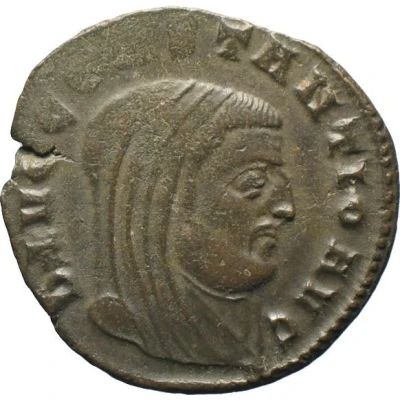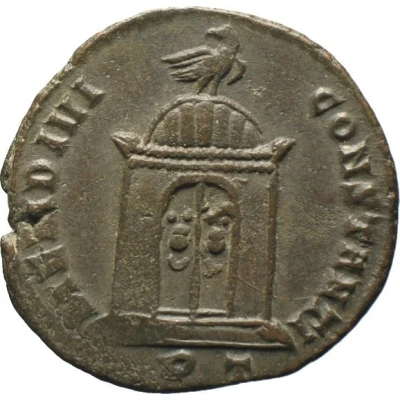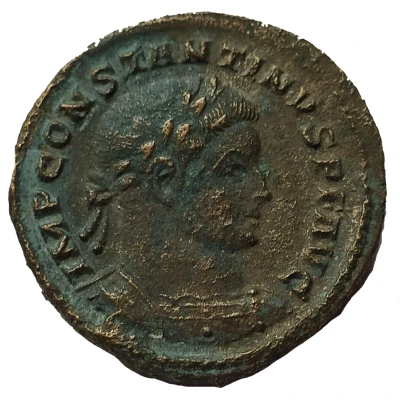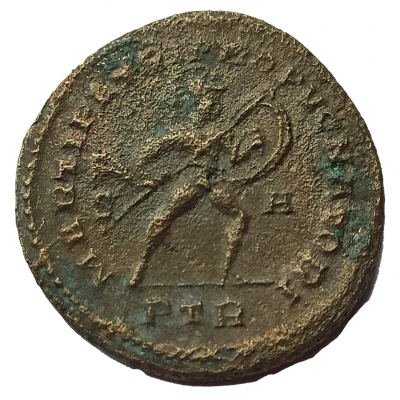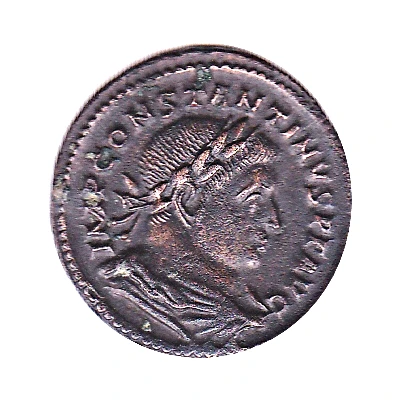
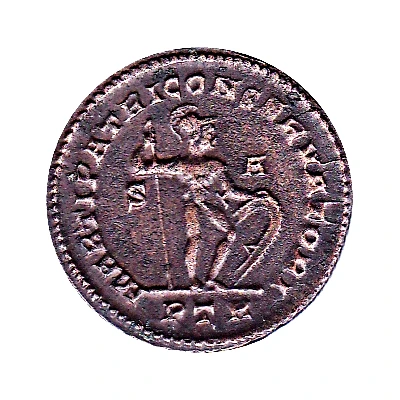

© JM
Nummus - Constantinus I MARTI PATRI CONSERVATORI; Treveri
| Bronze | 6.72 g | 26 mm |
| Issuer | Rome › Roman Empire (27 BC - 395 AD) |
|---|---|
| Emperor | Constantine I (Flavius Valerius Constantinus) (306-337) |
| Type | Standard circulation coin |
| Years | 307-308 |
| Value | Nummus / Follis (¼) |
| Currency | Argenteus, Reform of Diocletian (AD 293/301 – 310/324) |
| Composition | Bronze |
| Weight | 6.72 g |
| Diameter | 26 mm |
| Shape | Round (irregular) |
| Technique | Hammered |
| Orientation | Coin alignment ↑↓ |
| Demonetized | Yes |
| Updated | 2024-10-05 |
| Numista | N#154373 |
|---|---|
| Rarity index | 95% |
Reverse
Mars on his feet, turning to the right, holding a lance and a shield in his hands; S / A in the fields and PTR underneath.
Script: Latin
Lettering: MARTI PATRI CONSERVATORI
Translation: "In honor of Mars, protector of the homeland".
Comment
At the beginning of spring 307, Constantine planned a new campaign in German territory. He found it necessary to confront the Franks, Chamavi, Bructeri, Cherusci and Alemanni. The young emperor had been educated in the military training ground of the east by Diocletian and Galerius and, despite his youth, conducted the war with the sort of determination and energy which his father had not been able to muster in the preceding years. In the course of the military operations, he achieved important successes, managing to heavily wallop the Franks who had invaded the Roman territory east of the Rhine the previous year. It is reported that, while the Franks were planning to cross the Lower Rhine, Constantine quickly crossed the river in another location and surprised the enemy with an unexpected attack, which prevented a new invasion. Many of the Franks were killed, captured or enslaved – some of these were employed as gladiators. All their livestock was seized and their villages were burnt to the ground. As a result of these successes, Constantine was awarded the cognomen Germanicus Maximus at the end of the year. In the course of this campaign and those following it, Constantine may have used the legionary fortress of Castra Vetera as a base and the valley of the Lippe (as had been done in the time of Augustus and again fifty years later under Julian) as an invasion route by which to outflank the enemy, who were found to the north of this major river, and catch them from behind after devastating their territory.Interesting fact
The Nummus - Constantinus I coin was part of a series of coins issued during the reign of Emperor Constantine the Great, who ruled the Roman Empire from 306 to 337 AD. This particular coin was minted in the city of Treveri (modern-day Trier, Germany) and features an image of the emperor on one side and the god Mars on the other. The inscription "MARTI PATRI CONSERVATORI" translates to "To Mars, the father and protector," highlighting the importance of the god Mars in Roman mythology and the emperor's association with him. It's interesting to note that the Nummus - Constantinus I coin was made of bronze, a common metal used for coins during that time period, and weighed around 6.72 grams. Despite its relatively small size and weight, this coin is a valuable piece of history that provides insight into the economic and political systems of the Roman Empire during the 4th century AD.
